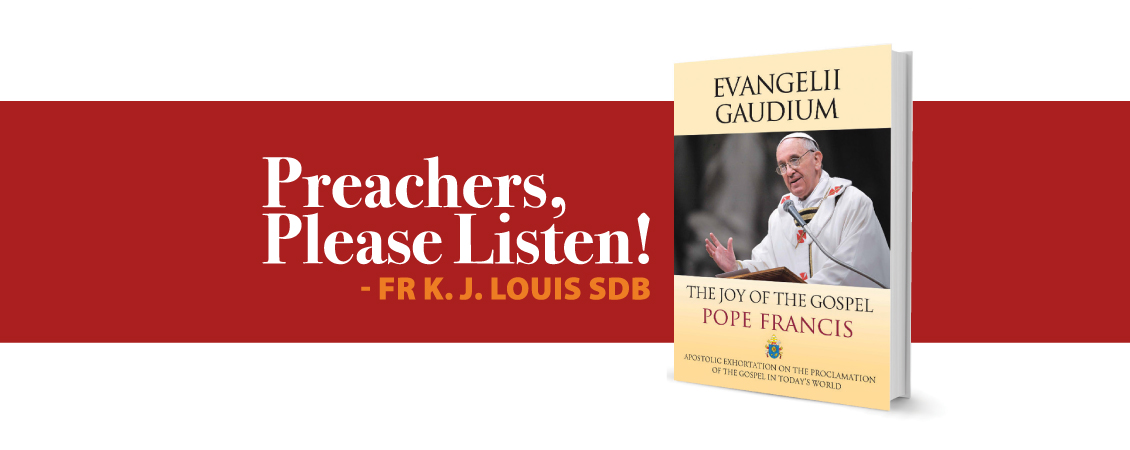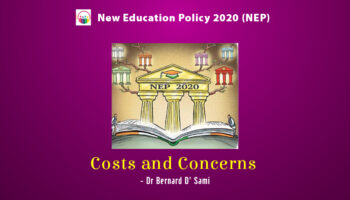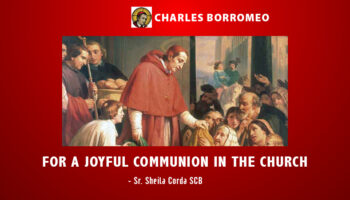In his Apostolic Exhortation, Evangelii Gaudium, Pope Francis has devoted 20 pages (out of 212) —that is, nearly ten percent of the document— to the homily and its preparation. He begins in a lighter vein by quipping that both the people and their ordained ministers suffer because of homilies: the laity from having to listen to them and the clergy from having to preach them! Then he goes on to make very practical and down-to-earth suggestions on what a homily should be and what preparation it demands. This is perhaps the first time that an Apostolic Exhortation gives so much attention to the homily. I have tried to summarise his thoughts by gathering them under six headings: 1. The Homily: what it is and what it is not, 2. The Preacher, 3. The Message, 4. The Style, 5. The Preparation, and 6. The Marks of a Good Homily. (Numbers in brackets refer to the paragraphs in Evangelii Gaudium).
1.THE HOMILY: WHAT IT IS AND WHAT IT IS NOT
The liturgy is a dialogue between God and his people. The homily is meant to facilitate this dialogue (143). The homily, in fact, is God speaking to his people with the preacher as a facilitator. The preacher is an instrument to express God’s word and the people’s own feelings so that afterward they can continue the conversation, says Pope Francis. At the same time, the homily is not a “form of entertainment” (138). Neither is it supposed to be a weekly commentary on current events; nor is it a lecture on biblical exegesis (138). It is not even meant to be a catechetical session or even a meditation. This does not mean that exegesis, doctrinal instruction and catechesis have no place whatsoever in a homily.
The homily should guide the assembly and the preacher to a life-changing communion with Christ in the Eucharist (138). It is quasi-sacramental, since faith comes from what is heard (142) and it is meant to help form a people to be evangelized evangelizers, not an exclusive or elite group.
2.THE PREACHER
Pope Francis says several things about the preacher of the Word. First of all, people today thirst for authenticity, and want preachers who speak of a God they know (150). They look for credible witnesses. The preacher should be close to people, approachable, welcoming, warm, joyful, unpretentious, ready for dialogue, and patient.
For this reason, the preacher needs to keep his ear to the people and find what they need to hear (154). He must first contemplate the Word, then contemplate his people, their habits, aspirations, limitations, worldviews, learning their language, so that he can link the homily to their human situation that needs God’s word (154). The homily is the touchstone for judging a pastor’s closeness and ability to communicate to his people. (135) The preacher must know the heart of his community (137). In short, the preacher’s task is to look at the world through the lens of the Word of God and indicate where God is working in the “here and now” of the community and in the individual lives of believers.
3.THE MESSAGE
The message, Pope Francis says quoting John Paul II, is the “joyful, patient, progressive preaching” of the incarnation, birth, life, saving death and resurrection of Jesus Christ — in other words, the “kerygma.” To preach the kerygma, the preacher must first believe it. The centre and hero of the homily has to be Jesus, not the minister.
Earlier in the exhortation, Pope Francis speaks of the proportion that has to be maintained in preaching. For example, if in the course of the liturgical year a parish priest speaks about temperance ten times but only mentions charity or justice two or three times, an imbalance results, and precisely those virtues which ought to be most present in preaching and catechesis are overlooked. The same thing happens when we speak more about law than about grace, more about the Church than about Christ, more about the Pope than about God’s word” (38).
4.THE STYLE
Pope Francis says good preaching means not just knowing what to say but knowing how to say it (156). He laments that preachers often don’t take the trouble to find the proper way to proclaim the message. He says it is a great act of love of neighbour to refuse to offer a product of poor quality to the people (156). Quoting Pope Paul VI, he says “the faithful expect much from preaching, and will greatly benefit from it, provided that it is simple, clear, direct, and well-adapted” (158).
The pope exhorts preachers to use imagery. “An attractive image makes the message seem familiar, close to home, practical and related to everyday life.” A good homily, he says, should have “an idea, a sentiment, an image” (157).
5.THE PREPARATION
Preparation is so important that one should devote to it a “prolonged time of study, prayer, reflection and pastoral creativity” (145), says Pope Francis. Pastors who don’t have enough time to prepare their homilies should re-set their priorities, even if less time will be given to other important activities. A preacher who doesn’t prepare, he says, “is not spiritual but dishonest and irresponsible with the gifts he has received” (145). The preparation should begin with prayer and humility of heart to recognize that ‘we are neither masters nor owners of the Word, but only its guardians, heralds and servants.’ We need to be ready to put aside all other concerns, and give it our time, interest and undivided attention (146). The Pope recommends that preachers have recourse to lectio divina, which consists of reading, meditation, prayer, and contemplation (152).
6.THE MARKS OF A GOOD HOMILY
- It should be Scriptural. The biblical text has to be the foundation of our preaching. The preacher must “develop great personal familiarity with the word of God” (149). Exegetical and linguistic aspects are not enough, but “a docile and prayerful heart” is needed (149). The Word must become “incarnate in the preacher’s daily life” so that the preaching becomes, in the words of St. Thomas Aquinas, “communicating to others what one has contemplated” (150). We must “be penetrated by the word” (150) before we think about proclaiming it to others. If the Word has not really touched the preacher’s life, “he will indeed be a false prophet, a fraud, a shallow impostor” (151).
- It should be simple. Simplicity shows itself in the language we use, so that people can understand it (158). To adapt language to the people, we need to share their lives and pay loving attention to them. The preacher must maintain clarity and thematic unity so that people can easily grasp his line of argument. He should use familiar, practical, everyday imagery, to make the message memorable. Images can help people to “savour the message, awaken desire and move the will” (157).
- It should be positive. The homilist should point out not so much what shouldn’t be done, but rather what we can do better, says Pope Francis. It should indicate the positive and attractive values, filling listeners with hope, liberating them from negativity. “Positive preaching always offers hope, points to the future, does not leave us trapped in negativity” (159).
- It should be brief. The homilist must keep to the point and learn to say it all in a few words. “It should be brief and avoid taking on the semblance of a speech or a lecture … If it is too long it will upset the balance and rhythm of the liturgy” (138). It is wise to follow what the Bible says about brevity in speech, “Speak concisely, say much in a few words” (Sirach 32:8), says Pope Francis. This remains a big challenge to many homilists. We all need to learn the art of saying much in a few words.
Perhaps it is appropriate to mention here that, a year after Evangelii Gaudium, the Church brought out another document entirely dealing with preaching — the Homiletic Directory. This 120-page document should be a necessary reference point for all engaged in the ministry of preaching.
– Fr. K. J. Louis SDB is a well-knownwriter, editor and preacher.
To subscribe to the magazine Contact Us





